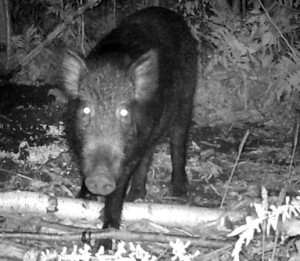Lions and Tigers and — Pigs?
Back in January, NCPR’s Brian Mann reported on the feral pig problem in the North Country. The story garnered a lot of comments, probably because of its juicy headline–“Feral Hogs Invade Champlain Valley, Adirondacks”–and creepy pictures.
Today the New York Times details the problem, with this equally apocolyptic header: “Wily, Elusive Foragers Invade Upstate New York.” Feral pigs are not, the NYT reports,
“the gentle, pink cousins of Wilbur from “Charlotte’s Web,” E. B. White’s children’s classic.”
The idea of hogs-gone-wild may elicit a chuckle from those of us who aren’t plagued by the unwanted creatures. But their rapid proliferation across the eastern Adirondacks has serious repurcussions for the ecosystem.
“There’s a real sense of urgency,” said Ed Reed, a wildlife biologist for the state’s Department of Environmental Conservation. “Once the pigs get established, they are very difficult to eradicate completely.”
The solution: trapping the pigs, and allowing hunters with small game licenses to shoot, keep, and kill all the feral swine they want. But farmers and wildlife conservationists alike are worried. Feral pigs are a nemesis not to be taken lightly:
“They eat everything,” Mr. Reed said. “They’ll eat the understory in a forest and dig up plants by rooting the ground for insects and roots. They compete with wildlife for food. They’re the most destructive mammal out there.”
Tags: adirondacks, champlainvalley, chpv, environment, invasives









New York needs a more aggressive invasive species program. I realize there’s no money to send out thousands of workers to eradicate the pigs, the Japanese Knotweed, the Boxelder, the Zebra Mussel, or even the brand new Roundup ready pigweed, but we are being buried. The reproductive rates of these species are unbelievable and you don’t have to be a math major to figure out that the window of opportunity is only open for a minute or two. The public will need help. Bounty programs might work (at least with the pigs), and some other mechanism for getting folks to pitch in might emerge. Education is the first step.
“Once the pigs get established, they are very difficult to eradicate completely.”
This makes it sound like there’s a period of time before the pigs “get established” when they’re easy to eradicate. Sounds like wishful thinking to me. Once they’re here, they’re difficult, period.
Came accross this on Slate awhile back. Interesting point about what is an invasive. I like the suggestion it’s merely another form of globalization, and also the distinction that it may only be invasive if it’s spread was assisted by man, not be nature.
That said, i think the pigs will be destructive, and agree with both posts above, introduce a bounty, and expeditiously.
silly me forgot to add link!
http://www.slate.com/articles/health_and_science/green_room/2009/11/dont_sweat_the_invasion.html
Given how hard they are to eradicate, I’d be interested in hearing what is being done to address the problem at its source.
Most reporting seems to speculate that these animals originated at a hunting ranch. Is it even legal for these ranches to have these pigs, and if so, is anyone trying to change that?
Pigs share a lot with humans or maybe it is the other way around.
Humans will procreate like pigs, often live like pigs although pigs would prefer not to live like human pigs, pigs can ruin their environment almost as fast as humans can ruin their environment and pigs, just like humans, will eat just about anything.
This is a boaring topic. More seriously, let’s not underestimate our ability to handle this. After all, in the past we have done an excellent job of hunting various species to extinction or reduced large populations to very small populations. Witness the carrier pigeon and the buffalo. Around 1900 the beaver had been eradicated from NYS and white tail deer were scarce.
“They’re the most destructive mammal out there”
Humans at their finest blaming other animals for being “the most destructive”. I think not. Try glancing into a mirror, there one will observe the image of the most destructive mammal that has ever lived on Earth.
Don’t believe me? Google; Alberta Tar Sands, Rain Forest Destruction, Open Pit Mining, Mountain Top Removal and on and on.
The extremely mild winter we’ve had here makes me worry that we may see them here before long. It’s been a long running joke here that the cold winters were great ’cause it kept the rif-raf out, but this past winter wouldn’t scare anyone.
When do we get rattlesnakes?
Texas kills thousands and thousands each year, its wide open kill as many as you can as fast as you can (they have contests), and people love to hunt there; yet they still persist with little progress made.
Hunting won’t do it. To get rid of them you would need something stronger or possibly really hit them hard right now maybe hunting could help.
40 below would be the best defense though.
Since it’ll never be 40 below again, I think we need to establish a bounty…fifty dollars for a pigss tail, and a fence along the New Jersey border to keep them and Christie out.
Bounties might work; could be expensive though. Lets see three litters per year; 10 per liter, one female pig produces 30-40 piglets every year, they can start breeding within a year, the math gets big real fast. So not even using the multipliers on the next generation; 20 female pigs a couple of boars and you have got 800 pig in one year, UNLESS you can get a good winter kill.
I wish deer reproduced like that or bears!